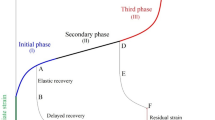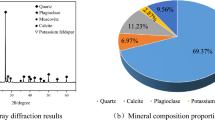Abstract
To evaluate the deterioration degree of rock freeze–thaw damage in cold area engineering, it is necessary to establish an accurate freeze–thaw rock damage model and its uniaxial compression numerical simulation method. Therefore, indoor freeze–thaw cycle tests of saturated yellow sandstone were carried out. The porosity and P-wave velocity were measured, and uniaxial compression tests were conducted after different numbers of freeze–thaw cycles. The findings indicate that with an increasing number of freeze–thaw cycles, the elastic modulus, peak strength and wave velocity of the yellow sandstones gradually decrease, while the peak strain and the average porosity increase. The energy evolution law with different numbers of freeze–thaw cycles was analyzed, a freeze–thaw damage model was established according to the relative change in the dissipated energy ratio before and after freezing–thawing, and the accuracy of this damage model and five common damage models was evaluated by the uniaxial compressive strength and peak strain. The functional relationship between mesoscopic parameters and the number of freeze–thaw cycles was formulated to establish a numerical simulation method for saturated sandstones under uniaxial compression after freeze–thaw cycling. The reliability of the numerical method was verified by comparing the stress–strain curve, peak stress, peak strain and energy law with the experimental results.





































Similar content being viewed by others
References
Altindag R, Alyildiz IS, Onargan T (2004) Mechanical property degradation of ignimbrite subjected to recurrent freeze–thaw cycles. Int J Rock Mech Min Sci 41(6):1023–1028. https://doi.org/10.1016/j.ijrmms.2004.03.005
Bai SH (2015) Experimental study on energy evolution and damage characteristics of fractured rock mass under cyclic loading. Chengdu University of Technology (in Chinese)
Chen W, Konietzky H, Tan X, Frühwirt T (2016) Pre-failure damage analysis for brittle rocks under triaxial compression. J Comput Geotech 74:45–55. https://doi.org/10.1016/j.compgeo.11,018
Deng HW, Yu S, Deng J, Ke B, Bin F (2019) Experimental investigation on energy mechanism of freezing–thawing treated sandstone under uniaxial static compression. KSCE J Civ Eng 23(5):2074–2082. https://doi.org/10.1007/s12205-019-1278-5
Duan A, Chen J, Jin WL (2013) Numerical simulation of the freezing process of concrete. J Mater Civ Eng 25(9):1317–1325. https://doi.org/10.1061/(ASCE)MT.1943-5533.0000655
Fan L, Li FH, Zhang YW, Cui SA, Li JL (2013) Research into the concrete freeze–thaw damage mechanism based on the principle of thermodynamics. J Constr Build Mater 357–360:751–756. https://doi.org/10.1016/10.4028/www.scientific.net/AMM.357-360.751
Gao F, Cao S, Zhou K, Lin Y, Zhu L (2020) Damage characteristics and energy-dissipation mechanism of frozen–thawed sandstone subjected to loading. J Cold Reg Sci Tech 169(2020):102920. https://doi.org/10.1016/j.coldregions.2019.102920
Guo J, Xu G, Jing H, Kuang T (2013) Fast determination of meso-level mechanical parameters of PFC models. Int J Min Sci Tech 23(1):157–162. https://doi.org/10.1016/j.ijmst.03,007
Hassanzadegan A, Blöcher G, Milsch H (2014) The effects of temperature and pressure on the porosity evolution of flechtinger sandstone. J Rock Mech Rock Eng 47(2):421–434
Huang YH, Yang SQ, Ranjith PG, Zhao J (2017) Strength failure behavior and crack evolution mechanism of granite containing pre-existing non-coplanar holes. J Comput Geotech 88:182–198. https://doi.org/10.1016/j.compgeo.2017.03.015
Inserra C, Biwa S, Chen Y (2013) Influence of thermal damage on linear and nonlinear acoustic properties of granite. J Int J Rock Mech Min Sci 62:96–104. https://doi.org/10.1016/j.ijrmms.2013.05.001
Jia HL, Xiang W, Krautblatter M (2015) Quantifying rock fatigue and decreasing compressive and tensile strength after repeated freeze-thaw cycles. J Permafrost Periglacial Process 26:368–377. https://doi.org/10.1002/ppp.1857
Jin J, Cao P, Chen Y, Pu C, Mao D, Fan X (2017) Influence of single flaw on the failure process and energy mechanics of rock-like material. J Comput Geotech 86:150–162. https://doi.org/10.1016/j.compgeo.01.011
Kachanov LM (1958) Time of the rupture process under creep conditions. J Izv Akad Nauk SSR Otd Tech Nauk 8:26–31
Kawamoto T, Ichikawa Y, Kyoya T (1988) Deformation and fracturing behaviour of discontinuous rock mass and damage mechanics theory. Int J Numer Anal Methods Geomech. 12(1):1–30. https://doi.org/10.1002/nag.1610120102
Ke B, Zhou K, Deng H, Bin F (2017) NMR pore structure and dynamic characteristics of sandstone caused by ambient freeze–thaw action. J Shock Vib 2017(4):1–10. https://doi.org/10.1155/2017/9728630
Khazaei C, Hazzard J, Chalaturnyk R (2015) Damage quantification of intact rocks using acoustic emission energies recorded during uniaxial compression test and discrete element modeling. J Comput Geotech 67:94–102. https://doi.org/10.1016/j.compgeo.2015.02.012
Krautblatter M, Funk D, Günzel FK (2013) Why permafrost rocks become unstable: a rock-ice-mechanical model in time and space. J Earth Surf Process Landf 38(8):876–887. https://doi.org/10.1002/esp.3374
Lemaitre J (1984) How to use damage mechanics. J Nucl Eng Des 80(2):233–245. https://doi.org/10.1016/0029-5493(84)90169-9
Li JL, Kaunda RB, Zhou KP (2018) Experimental investigations on the effects of ambient freeze–thaw cycling on dynamic properties and rock pore structure deterioration of sandstone. J Cold Reg Sci Technol 154:133–141. https://doi.org/10.1016/j.coldregions.2018.06.015
Lin H, Lei D, Yong R, Jiang C, Du S (2020) Analytical and numerical analysis for frost heaving stress distribution within rock joints under freezing and thawing cycles. J Environ Earth Sci. https://doi.org/10.1007/s12665-020-09051-x
Liu Q, Huang S, Kang Y, Liu X (2015) A prediction model for uniaxial compressive strength of deteriorated rocks due to freeze–thaw. J Cold Reg Sci Tech 120:96–107. https://doi.org/10.1016/j.coldregions.2015.09.013
Liu WW, Feng Q, Wang CX, Lu CK, Xu ZZ, Li WT (2019) Analytical solution for three-dimensional radial heat transfer in a cold region tunnel. J Cold Reg Sci Technol 164:1–12. https://doi.org/10.1016/j.coldregions.2019.102787
Matsuoka N (1990) Mechanisms of rock breakdown by frost action: an experimental approach. Cold Reg Sci Technol 17:253–270. https://doi.org/10.1016/s0165-232x(05)80005-9
Mutlutürk M, Altindag R, Türk G (2004) A decay function model for the integrity loss of rock when subjected to recurrent cycles of freezing-thawing and heating–cooling. Int J Rock Mech Min Sci 41(2):237–244. https://doi.org/10.1016/S1365-1609(03)00095-9
Pan WH, Sun XD, Wu LM, Yang KK, Tang N (2019) Damage detection of asphalt concrete using piezo-ultrasonic wave technology. J Mater. https://doi.org/10.3390/ma12030443
Petersen L, Lohaus L, Polak MA (2007) Influence of freezing -and -thawing damage on behavior of reinforced concrete elements. J ACI Mater J 104(4):369–378
Potyondy DO, Cundall PA (2004) A bonded-particle model for rock. Int J Rock Mech Min Sci 41(8):1329–1364. https://doi.org/10.1016/j.ijrmms.2004.09.011
Pudasaini SP, Krautblatter M (2014) A two-phase mechanical model for rock-ice avalanches. J Geophys Res Earth 119(10):2272–2290. https://doi.org/10.1002/2014jf003183
Qiu WL, Teng F, Teng SS (2020) Damage constitutive model of concrete under repeated load after seawater freeze–thaw cycles. J Constr Build Mater 236:117560. https://doi.org/10.1016/j.conbuildmat.2019.117560
Remy JM, Bellanger M, Homand-Etienne F (1994) Laboratory velocities and attenuation of P-waves in limestones during freeze–thaw cycles. J Geophys 59:245–251. https://doi.org/10.1190/1.1443586
Takarli M, Pince W, Siddique R (2008) Damage in granite under heating/cooling cycles and water freeze-thaw condition. J Int J Rock Mech Min Sci 45:1164–1175. https://doi.org/10.1016/j.ijrmms.2008.01.002
Tan X, Chen W, Yang J, Cao JJ (2011) Laboratory investigations on themechanical properties degradation of granite under freeze-thaw cycles. J Cold Reg Sci Tech 68(3):130–138. https://doi.org/10.1016/j.coldregions.2011.05.007
Wang S, Qi J, Yu F, Liu F (2016) A novel modeling of settlement of foundations in permafrost regions. J Geomech Eng 10(2):225–245. https://doi.org/10.12989/gae.2016.10.2.225
Wang P, Xu JY, Fang XY, Wang PX (2017) Energy dissipation and damage evolution analyses for the dynamic compression failure process of red-sandstone after freeze-thaw cycles. J Eng Geol 221:104–113. https://doi.org/10.1016/j.enggeo.2017.02.025
Wang C, Zhan SF, Xie MZ, Wang C, Cheng LP, Xiong ZQ (2020) Damage characteristics and constitutive model of deep rock under frequent impact disturbances in the process of unloading high static stress. J Complexity 2020:1–15. https://doi.org/10.1155/2020/2706091
Xie HP, Ju Y, Li LY (2005) Criteria for strength and structural failure of rocks based on energy dissipation and energy release principles. J Cold Reg Sci Tech 24(17):3003–3010. https://doi.org/10.3321/j.issn:1000-6915.2005.17.001
Xing K, Zhou Z, Yang H, Liu B (2020) Macro–meso freeze–thaw damage mechanism of soil–rock mixtures with different rock contents. Int J Pavement Eng 21(1):9–19. https://doi.org/10.1080/10298436.2018.1435879
Yang SQ, HuangM YH, Jing HW, Liu XR (2014) Discrete element modeling on fracture coalescence behavior of red sandstone containing two unparallel fissures. J Eng Geol 178:28–48. https://doi.org/10.1016/j.enggeo.2014.06.005
Zhang HM, Wang H, Zhang JF, Cheng SF, Zhou HW (2020) Analysis of meso-damage characteristics of freeze-thaw rocks at CT scale. J Liaoning Tech Univ (nat Sci Ed) 39(01):51–56. https://doi.org/10.11956/j.issn.1008-0562.2020.01.008 (in Chinese)
Zhou Z, Xing K, Yang H, Wang H (2019) Damage mechanism of soil-rock mixture after freeze–thaw cycles. J Central South Univ 26(1):13–24. https://doi.org/10.1007/s11771-019-3979-9
Zou Q, Lin B (2017) Modeling the relationship between macro- and meso-parameters of coal using a combined optimization method. J Environ Earth Sci 76(14):479.1-479.20. https://doi.org/10.1007/s12665-017-6816-1
Zuber B, Marchand J (2004) Predicting the volume instability of hydrated cement systems upon freezing using poro-mechanics and local phase equilibria. J Mater Struct 37(268):257–270. https://doi.org/10.1007/BF02480634
Acknowledgements
This work was supported by the Natural Science Foundation of Shandong Province (ZR2016JL018), Research and Innovation Team Project of College of Civil Engineering and Architecture, Shandong University of Science and Technology (2019TJKYTD02), and Project of Shandong Province Higher Educational Young Innovative Talent Introduction and Cultivation Team (Disaster prevention and control team of underground engineering involved in sea).
Author information
Authors and Affiliations
Contributions
QF: Supervision, Conceptualization, Writing—review and editing. JJ: Formal analysis, Methodology, Software, Writing—original draft. SZ: Validation, Software. WL: Conceptualization, Data curation, Writing—review. XY: Resources, Validation. WL: Investigation.
Corresponding author
Ethics declarations
Conflict of Interest
The authors declare that they have no known competing financial interests or personal relationships that could have appeared to influence the work reported in this paper.
Additional information
Publisher's Note
Springer Nature remains neutral with regard to jurisdictional claims in published maps and institutional affiliations.
Rights and permissions
About this article
Cite this article
Feng, Q., Jin, J., Zhang, S. et al. Study on a Damage Model and Uniaxial Compression Simulation Method of Frozen–Thawed Rock. Rock Mech Rock Eng 55, 187–211 (2022). https://doi.org/10.1007/s00603-021-02645-2
Received:
Accepted:
Published:
Issue Date:
DOI: https://doi.org/10.1007/s00603-021-02645-2




